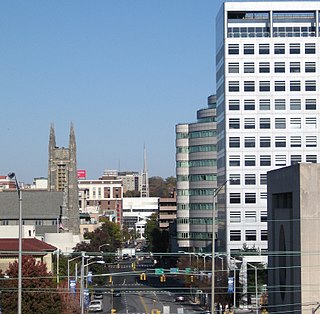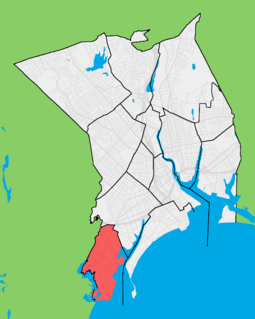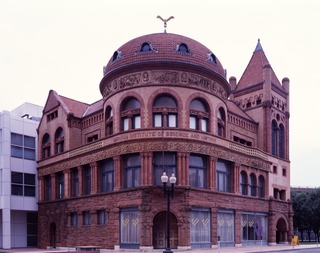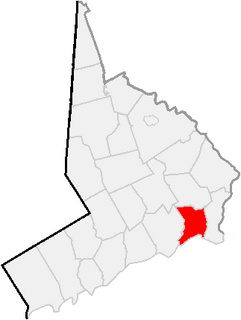
Fairfield County is a county in the southwestern corner of the U.S. state of Connecticut, as well as the State’s fastest-growing from 2010 to 2020 and largest in terms of population. As of the 2020 census, the county's population was 957,419, representing 26.6% of Connecticut's overall population. The closest to the center of the New York metropolitan area, the county contains four of the state's largest cities–Bridgeport (1st), Stamford (3rd), Norwalk (6th), and Danbury (7th)–whose combined population of 433,368 is nearly half the county's total population.

The Minnesota Correction Facility – Stillwater (MCF-STW) is a close custody state prison for men in Bayport, Minnesota, United States. Built 1910–1914, it houses 1,600 inmates in seven different living areas. Additionally, approximately 100 inmates are housed in a nearby minimum security area. It replaced the original Minnesota Territorial Prison located just to the north in the city of Stillwater, Minnesota. Until recent expansion of the medium custody Minnesota Correctional Facility – Faribault, MCF-STW was the state's largest facility by inmate population. A historic district consisting of 22 contributing properties was listed on the National Register of Historic Places in 1986 as the State Prison Historic District for having state-level significance in architecture. It was nominated for being one of the nation's earliest and most influential appearances of the "telephone pole" layout, with a large main hallway connecting each of the units, that was widely adopted by high-security prisons. MCF-STW is noted for its award-winning publication The Prison Mirror, the oldest continuously-operated prison newspaper in the United States.

Black Rock is a neighborhood in the southwestern section of the city of Bridgeport, Connecticut. It borders Fairfield and the Ash Creek tidal estuary on the west, the West Side/West End of Bridgeport on the north and east, and Black Rock Harbor and Long Island Sound on the south. Black Rock comprises census tracts 701 and 702 and part of census tract 703. It includes two historic districts listed on the National Register of Historic Places. Residences comprise 86% of properties in Black Rock, 10% are commercial, and 4% are industrial or other property classes.

The Barnum Museum is a museum at 820 Main Street in Bridgeport, Connecticut, United States. It has an extensive collection related to P. T. Barnum and the history of Bridgeport, and is housed in a historic building on the National Register of Historic Places.

The Black Rock Historic District is a predominantly residential historic district in the Black Rock section of Bridgeport, Connecticut. It was listed on the National Register of Historic Places in 1979. At that time it included 109 contributing buildings. The historic district surrounds at the upper reaches of Black Rock Harbor.

The Main Street Historic District in Danbury, Connecticut, United States, is the oldest section of that city, at its geographical center. It has long been the city's commercial core and downtown. Its 132 buildings, 97 of which are considered contributing properties, include government buildings, churches, commercial establishments and residences, all in a variety of architectural styles from the late 18th century to the early 20th. It is the only major industrial downtown of its size in Connecticut not to have developed around either port facilities or a water power site.

The Southport Historic District in the town of Fairfield, Connecticut is a 225-acre (91 ha) area historic district that was listed on the National Register of Historic Places in 1971. It preserves a portion of the modern neighborhood and former borough of Southport, Connecticut. Since the British burnt almost all of Southport's structures in 1779, there is only one home built prior to that date, the Meeker House at 824 Harbor Road, which survives.

This is a list of the National Register of Historic Places listings in Bridgeport, Connecticut.

Bridgeport is a historic seaport city in the U.S. state of Connecticut, and its largest city. With a population of 148,654 in 2020, it is also the fifth-most populous in New England. Located in Fairfield County at the mouth of the Pequonnock River on Long Island Sound, it is 60 miles (97 km) from Manhattan and 40 miles (64 km) from The Bronx. It is bordered by the towns of Trumbull to the north, Fairfield to the west, and Stratford to the east. Bridgeport and other settlements in Fairfield County make up the Bridgeport-Stamford-Norwalk-Danbury metropolitan statistical area, the second largest metropolitan area in Connecticut. The Bridgeport-Stamford-Norwalk-Danbury metropolis forms part of the New York megacity.

McLevy Hall is a historic municipal building at 202 State Street in downtown Bridgeport, Connecticut. The building was built in 1854 to house both the City Hall and the Fairfield County Courthouse, and served as Bridgeport City Hall into the 1930s. It was renamed McLevy Hall after Bridgeport mayor Jasper McLevy in 1966. The current city hall on Lyon Terrace was built in 1916, however municipal offices continued to occupy McLevy Hall through the 1970s. It was added to the National Register of Historic Places on September 19, 1977.

The old Essex County Jail is located in the University Heights section of Newark, Essex County, New Jersey, United States. The jail is Essex County's oldest public building and a national landmark of value for its architectural and social history. The complex consists of about 20 structures of various size, age, and function ranging in date from the 1830s to 1930s. Collectively, they represent the evolution of American prison history over 100 years. For the quality of its architecture, its social history, and its links to the 1967 Newark Riots, this jail was added to the National Register of Historic Places on September 3, 1991.

The Fairfield County Courthouse, also known as the Court of Common Pleas, is located at 172 Golden Hill Street in downtown Bridgeport, Connecticut. It is also known as Geographical Area (GA) Courthouse No. 2 at Bridgeport. It is a Richardsonian Romanesque brick building built in 1888. It was listed on the National Register of Historic Places in 1982. It still functions as a courthouse where all but the most serious criminal cases are heard.

The Mary and Eliza Freeman Houses are historic residences at 352-4 and 358-60 Main Street in Bridgeport, Connecticut. The simple, clapboard-covered dwellings were built in 1848 in what became known as Little Liberia, a neighborhood settled by free blacks starting in the first quarter of the nineteenth century. As the last surviving houses of this neighborhood on their original foundations, these were added to the National Register of Historic Places on February 22, 1999. The houses are the oldest remaining houses in Connecticut built by free blacks, before the state completed its gradual abolition of slavery in 1848. The homes and nearby Walter's Memorial A.M.E. Zion Church are also listed sites on the Connecticut Freedom Trail.

The Bridgeport Downtown South Historic District encompasses the historic elements of the southern part of downtown Bridgeport, Connecticut. It is 27 acres (11 ha) in size, roughly bordered on the east by Main and Middle Streets, on the north by Elm Street, the west by Broad Street, and the south by Cesar Batalla Way. This area includes the highest concentration of buildings developed in the commercial downtown between about 1840 and the 1930s, the period of the city's major growth as a manufacturing center, and includes a diversity of architectural styles representative of that time period. The district was listed on the National Register of Historic Places in 1987.

The Bridgeport Downtown North Historic District encompasses a portion of the commercial downtown of Bridgeport, Connecticut. It isroughly bounded on the north by Congress Street, the east by Water and Middle Streets, the south by Fairfield Avenue, and the west by Lyon Terrace, roughly the northeastern quadrant of the downtown area. It is one of two large clusters of historically significant commercial and civic buildings encapsulating the city's growth as an urban industrial and regional government center. It was listed on the National Register of Historic Places in 1987.

The Hotel Beach, also known historically as the Hotel Barnum, is a historic hotel building at 140 Fairfield Ave. in Bridgeport, Connecticut. It is a thirteen-story Art Deco tower built in 1927 and designed by Thomas, Martin & Kirkpatrick. It is one of the city's outstanding Art Deco buildings, built when the city was at its peak. It was listed on the National Register of Historic Places in 1978. It is a contributing building in the Bridgeport Downtown North Historic District, NRHP-listed in 1987. It is currently a residential apartment building called Barnum House.
Bridgeport Correctional Center is a high-security state jail for men in Bridgeport, Connecticut. It was built in 1958 and received its first inmates the same year. It houses both pre-trial defendants and sentenced offenders for the courts of Ansonia, Derby, Milford, Bridgeport, Danbury, Norwalk, and Stamford.

St. John's Episcopal Church is a historic church at 768 Fairfield Avenue in Bridgeport, Connecticut. Built in 1873 for a congregation founded in the mid-18th century, it is a well-preserved design of James Renwick, Jr. and a good example of late 19th-century Gothic Revival archiecture. It was listed on the National Register in 1984.

The Burlington Traction Company is a historic trolley maintenance facility at Riverside Avenue and North Winooski Avenue in Burlington, Vermont. The property includes two brick trolley barns, built c. 1900 and c. 1910 respectively, that were used as public transit maintenance facilities until 1999, after which they were adaptively repurposed to other residential and commercial uses. The property was listed on the National Register of Historic Places in 2004.

The Cassidy House is a historic house at 691 Ellsworth Street in Bridgeport, Connecticut. Built in 1849, it is a well-preserved example of early Italianate residential architecture, and the only documented building in the city from that period which retains its original board and batten siding. It was listed on the National Register of Historic Places in 2011.


















